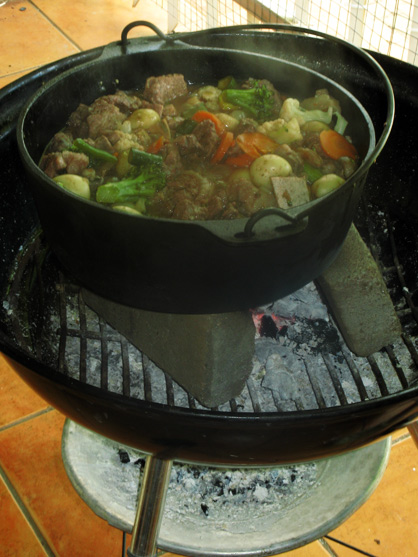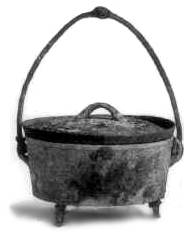|
Potbrood
Potbrood ("pot bread") is bread first made by the Boer settlers of what is now South Africa. Potbrood was traditionally baked in a cast-iron pot (also known as a Dutch oven) in a pit made in the ground and lined with hot coals. Today potbrood is often made at a braai by packing charcoal or wood coals around a cooking pot. See also * Potjiekos * Braai * List of African dishes There is a list of dishes found in African cuisine, a generalized term collectively referring to the cuisines of Africa. The continent of Africa is the second-largest landmass on Earth, and is home to hundreds of different cultural and Ethnic gro ... References Breads South African cuisine {{bread-stub ... [...More Info...] [...Related Items...] OR: [Wikipedia] [Google] [Baidu] |
List Of African Dishes
There is a list of dishes found in African cuisine, a generalized term collectively referring to the cuisines of Africa. The continent of Africa is the second-largest landmass on Earth, and is home to hundreds of different cultural and Ethnic group, ethnic groups. This wikt:diversity, diversity is also reflected in the many local culinary traditions in choice of ingredients, style of preparation, and Cooking, cooking techniques. African dishes } ''salat turki''). , - , Matoke , , Uganda , A meal consisting of steamed green Plantain (cooking), banana (or Plantain (cooking), plantain) and is one of the national dishes of Uganda. , - , Mbongo Tchobi , , Cameroon , A black soup made from the burnt mbongo spice, usually cooked with meat or fish and served with steamed ripe plantains. , - , Méchoui , , North Africa, Cameroon , A whole sheep or a lamb spit roasted on a barbecue. It is popular in North Africa and among the Bamileke people of Cameroon. , - , Melktert , ... [...More Info...] [...Related Items...] OR: [Wikipedia] [Google] [Baidu] |
Potjiekos
In South Africa, a potjiekos , literally translated "small-pot food", is a dish prepared outdoors. It is traditionally cooked in a round, cast iron, three-legged cauldron, the ''potjie'', descended from the Dutch oven brought from the Netherlands to South Africa in the 17th century and found in the homes and villages of people throughout southern Africa. The pot is heated using small amounts of wood or charcoal or, if fuel is scarce, twisted grass or even dried animal dung. History Traditionally, the recipe includes meat, vegetables like carrots, cabbage, cauliflower or pumpkin, starches like rice or potatoes, all slow-cooked with Dutch- Malay spices, the distinctive spicing of South Africa's early culinary melting pot. Other common ingredients include fruits and flour-based products like pasta. Potjiekos originated with the Voortrekkers, evolving as a stew made of venison and vegetables (if available), cooked in the potjie. As ''trekkers'' (pioneers) shot wild game, it ... [...More Info...] [...Related Items...] OR: [Wikipedia] [Google] [Baidu] |
South Africa
South Africa, officially the Republic of South Africa (RSA), is the southernmost country in Africa. It is bounded to the south by of coastline that stretch along the South Atlantic and Indian Oceans; to the north by the neighbouring countries of Namibia, Botswana, and Zimbabwe; and to the east and northeast by Mozambique and Eswatini. It also completely enclaves the country Lesotho. It is the southernmost country on the mainland of the Old World, and the second-most populous country located entirely south of the equator, after Tanzania. South Africa is a biodiversity hotspot, with unique biomes, plant and animal life. With over 60 million people, the country is the world's 24th-most populous nation and covers an area of . South Africa has three capital cities, with the executive, judicial and legislative branches of government based in Pretoria, Bloemfontein, and Cape Town respectively. The largest city is Johannesburg. About 80% of the population are Black South Afri ... [...More Info...] [...Related Items...] OR: [Wikipedia] [Google] [Baidu] |
Bread
Bread is a staple food prepared from a dough of flour (usually wheat) and water, usually by baking. Throughout recorded history and around the world, it has been an important part of many cultures' diet. It is one of the oldest human-made foods, having been of significance since the dawn of agriculture, and plays an essential role in both religious rituals and secular culture. Bread may be leavened by naturally occurring microbes (e.g. sourdough), chemicals (e.g. baking soda), industrially produced yeast, or high-pressure aeration, which creates the gas bubbles that fluff up bread. In many countries, commercial bread often contains additives to improve flavor, texture, color, shelf life, nutrition, and ease of production. History Bread is one of the oldest prepared foods. Evidence from 30,000 years ago in Europe and Australia revealed starch residue on rocks used for pounding plants. It is possible that during this time, starch extract from the roots of plants, such as c ... [...More Info...] [...Related Items...] OR: [Wikipedia] [Google] [Baidu] |
Bread
Bread is a staple food prepared from a dough of flour (usually wheat) and water, usually by baking. Throughout recorded history and around the world, it has been an important part of many cultures' diet. It is one of the oldest human-made foods, having been of significance since the dawn of agriculture, and plays an essential role in both religious rituals and secular culture. Bread may be leavened by naturally occurring microbes (e.g. sourdough), chemicals (e.g. baking soda), industrially produced yeast, or high-pressure aeration, which creates the gas bubbles that fluff up bread. In many countries, commercial bread often contains additives to improve flavor, texture, color, shelf life, nutrition, and ease of production. History Bread is one of the oldest prepared foods. Evidence from 30,000 years ago in Europe and Australia revealed starch residue on rocks used for pounding plants. It is possible that during this time, starch extract from the roots of plants, such as c ... [...More Info...] [...Related Items...] OR: [Wikipedia] [Google] [Baidu] |
Boer
Boers ( ; af, Boere ()) are the descendants of the Dutch-speaking Free Burghers of the eastern Cape Colony, Cape frontier in Southern Africa during the 17th, 18th, and 19th centuries. From 1652 to 1795, the Dutch East India Company controlled Dutch Cape Colony, this area, but the United Kingdom incorporated it into the British Empire in 1806. The name of the group is derived from "boer", which means "farmer" in Dutch language, Dutch and Afrikaans language, Afrikaans. In addition, the term also applied to those who left the British Cape Colony, Cape Colony Great Trek, during the 19th century to colonise in the Orange Free State, South African Republic, Transvaal (together known as the Boer Republics), and to a lesser extent Natalia Republic, Natal. They emigrated from the Cape to live beyond the reach of the British colonial administration, with their reasons for doing so primarily being the new Anglophone common law system being introduced into the Cape and the Slavery Abo ... [...More Info...] [...Related Items...] OR: [Wikipedia] [Google] [Baidu] |
Dutch Oven
A Dutch oven (not to be confused with masonry oven) is a thick-walled cooking pot with a tight-fitting lid. Dutch ovens are usually made of seasoned cast iron; however, some Dutch ovens are instead made of cast aluminium, or ceramic. Some metal varieties are enameled rather than being seasoned, and these are sometimes called French ovens. Dutch ovens have been used as cooking vessels for hundreds of years. They are often called casserole dishes in some English-speaking countries other than the United States ( means "cooking pot" in French), and in French. They are similar to both the Japanese and the , a traditional Balkan cast-iron oven, and are related to the South African , the Australian Bedourie oven and Spanish . History Early European history During the 17th century, brass was the preferred metal for English cookware and domestic utensils, and the Dutch produced it at the lowest cost, which, however, was still expensive. In 1702, Abraham Darby was a partner in the Bras ... [...More Info...] [...Related Items...] OR: [Wikipedia] [Google] [Baidu] |
Braai
Barbecue varies by the type of meat, sauce, rub, or other flavorings used, the point in barbecuing at which they are added, the role smoke plays, the equipment and fuel used, cooking temperature, and cooking time. The meat may be whole, ground (for hamburgers), or processed into sausage or kebabs. The meat may be marinated or rubbed with spices before cooking, basted with a sauce or oil before, during or after cooking, or any combination of these. Africa South Africa In South Africa, a ''braai'' (plural ''braais'') is a barbecue or grill and is a social custom in much of Southern Africa. The term originated with the Afrikaners, but has since been adopted by South Africans of many ethnic backgrounds. The Afrikaans word ''braaivleis'' (; ) means grilled meat. The word ''vleis'' is Afrikaans for meat, cognate with English ''flesh''. ''Braai'' is regarded by some as another word for barbecue, in that it serves as a verb when describing how food is cooked and a noun when desc ... [...More Info...] [...Related Items...] OR: [Wikipedia] [Google] [Baidu] |
Braai
Barbecue varies by the type of meat, sauce, rub, or other flavorings used, the point in barbecuing at which they are added, the role smoke plays, the equipment and fuel used, cooking temperature, and cooking time. The meat may be whole, ground (for hamburgers), or processed into sausage or kebabs. The meat may be marinated or rubbed with spices before cooking, basted with a sauce or oil before, during or after cooking, or any combination of these. Africa South Africa In South Africa, a ''braai'' (plural ''braais'') is a barbecue or grill and is a social custom in much of Southern Africa. The term originated with the Afrikaners, but has since been adopted by South Africans of many ethnic backgrounds. The Afrikaans word ''braaivleis'' (; ) means grilled meat. The word ''vleis'' is Afrikaans for meat, cognate with English ''flesh''. ''Braai'' is regarded by some as another word for barbecue, in that it serves as a verb when describing how food is cooked and a noun when desc ... [...More Info...] [...Related Items...] OR: [Wikipedia] [Google] [Baidu] |
Breads
Bread is a staple food prepared from a dough of flour (usually wheat) and water, usually by baking. Throughout recorded history and around the world, it has been an important part of many cultures' diet. It is one of the oldest human-made foods, having been of significance since the dawn of agriculture, and plays an essential role in both religious rituals and secular culture. Bread may be leavened by naturally occurring microbes (e.g. sourdough), chemicals (e.g. baking soda), industrially produced yeast, or high-pressure aeration, which creates the gas bubbles that fluff up bread. In many countries, commercial bread often contains additives to improve flavor, texture, color, shelf life, nutrition, and ease of production. History Bread is one of the oldest prepared foods. Evidence from 30,000 years ago in Europe and Australia revealed starch residue on rocks used for pounding plants. It is possible that during this time, starch extract from the roots of plants, such as catt ... [...More Info...] [...Related Items...] OR: [Wikipedia] [Google] [Baidu] |


